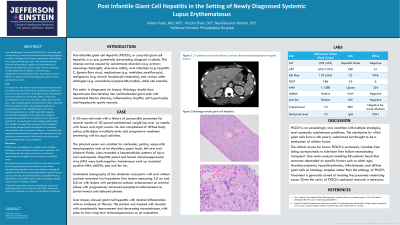Tuesday Poster Session
Category: Liver
P4785 - Post Infantile Giant Cell Hepatitis in the Setting of Newly Diagnosed Systemic Lupus Erythematosus
Tuesday, October 29, 2024
10:30 AM - 4:00 PM ET
Location: Exhibit Hall E

Has Audio
- MP
Misha Patel, MD, MS
Einstein Healthcare Network
Philadelphia, PA
Presenting Author(s)
Misha Patel, MD, MS, Prutha Shah, DO, Nandakumar Mohan, DO
Einstein Healthcare Network, Philadelphia, PA
Introduction: Post-infantile giant cell hepatitis (PIGCH), or syncytial giant cell hepatitis, is a rare but potentially devastating diagnosis in adults. Histology should show hepatocytes that develop into multinucleated giant cells with associated lobular disarray, inflammation, Kupffer cell hypertrophy and hepatocyte spotty necrosis [1]. Most common etiologies include autoimmune disorders, viral infections, medications, and malignancy. Here, we present a case of PIGCH in a patient with newly diagnosed systemic lupus erythematous (SLE).
Case Description/Methods: A 33-year-old male with a history of pericarditis presented for several months of 50-pound unintentional weight loss over six months with fevers and night sweats. The physical exam was notable for nontender, patchy, nonpruritic maculopapular rash on his shoulders, upper back and left arm. Labwork revealed alanine transaminase of 266, aspartate aminotransferase of 591, elevated gamma-glutamyl transpeptidase of 186. Hepatitis panel and human immunosuppressive virus (HIV) were both negative. Computed tomography of the abdomen and pelvis revealed two hypodense liver lesions measuring 2.0 cm and 0.8 cm. He was found to have largely positive ANA titer, double stranded DNA, and anti-smith antibodies. Liver biopsy showed giant cell hepatitis with minimal inflammation with no evidence of fibrosis. The patient was treated with steroids with symptomatic improvement and decreasing transaminases, with plans to start long term immunosuppression as an outpatient.
Discussion: PIGCH is an exceedingly rare condition with multiple etiologies, most commonly autoimmune conditions. The mechanism by which giant cells form is still poorly understood but thought to be a mechanism of cellular fusion.
The clinical course for known PIGCH is extremely variable from being asymptomatic to fulminant liver failure necessitating transplant. One meta-analysis including 68 patients found that outcomes depended on specific factors such as older age, thrombocytopenia, hypoalbuminemia, bilirubinemia, and diffuse giant cells on histology samples rather than the etiology of PIGCH.
Treatment is generally aimed at treating the presumed underlying cause. Given the rarity of PIGCH, continued research is necessary in order to understand this disease.
Reference
Jiao J, Zhang X. Post-infantile Giant Cell Hepatitis: A Literature Review and Meta-analysis. J Clin Transl Pathol. 2022;2(3):100-107. doi:10.14218/jctp.2022.00016

Disclosures:
Misha Patel, MD, MS, Prutha Shah, DO, Nandakumar Mohan, DO. P4785 - Post Infantile Giant Cell Hepatitis in the Setting of Newly Diagnosed Systemic Lupus Erythematosus, ACG 2024 Annual Scientific Meeting Abstracts. Philadelphia, PA: American College of Gastroenterology.
Einstein Healthcare Network, Philadelphia, PA
Introduction: Post-infantile giant cell hepatitis (PIGCH), or syncytial giant cell hepatitis, is a rare but potentially devastating diagnosis in adults. Histology should show hepatocytes that develop into multinucleated giant cells with associated lobular disarray, inflammation, Kupffer cell hypertrophy and hepatocyte spotty necrosis [1]. Most common etiologies include autoimmune disorders, viral infections, medications, and malignancy. Here, we present a case of PIGCH in a patient with newly diagnosed systemic lupus erythematous (SLE).
Case Description/Methods: A 33-year-old male with a history of pericarditis presented for several months of 50-pound unintentional weight loss over six months with fevers and night sweats. The physical exam was notable for nontender, patchy, nonpruritic maculopapular rash on his shoulders, upper back and left arm. Labwork revealed alanine transaminase of 266, aspartate aminotransferase of 591, elevated gamma-glutamyl transpeptidase of 186. Hepatitis panel and human immunosuppressive virus (HIV) were both negative. Computed tomography of the abdomen and pelvis revealed two hypodense liver lesions measuring 2.0 cm and 0.8 cm. He was found to have largely positive ANA titer, double stranded DNA, and anti-smith antibodies. Liver biopsy showed giant cell hepatitis with minimal inflammation with no evidence of fibrosis. The patient was treated with steroids with symptomatic improvement and decreasing transaminases, with plans to start long term immunosuppression as an outpatient.
Discussion: PIGCH is an exceedingly rare condition with multiple etiologies, most commonly autoimmune conditions. The mechanism by which giant cells form is still poorly understood but thought to be a mechanism of cellular fusion.
The clinical course for known PIGCH is extremely variable from being asymptomatic to fulminant liver failure necessitating transplant. One meta-analysis including 68 patients found that outcomes depended on specific factors such as older age, thrombocytopenia, hypoalbuminemia, bilirubinemia, and diffuse giant cells on histology samples rather than the etiology of PIGCH.
Treatment is generally aimed at treating the presumed underlying cause. Given the rarity of PIGCH, continued research is necessary in order to understand this disease.
Reference
Jiao J, Zhang X. Post-infantile Giant Cell Hepatitis: A Literature Review and Meta-analysis. J Clin Transl Pathol. 2022;2(3):100-107. doi:10.14218/jctp.2022.00016

Figure: A. CT abdomen pelvis with a 2.0 cm hypodense lesion. B & C. PAS-D stain of liver biopsy tissue showing focal diastase resistance small globules parenchyma liver cells
Disclosures:
Misha Patel indicated no relevant financial relationships.
Prutha Shah indicated no relevant financial relationships.
Nandakumar Mohan indicated no relevant financial relationships.
Misha Patel, MD, MS, Prutha Shah, DO, Nandakumar Mohan, DO. P4785 - Post Infantile Giant Cell Hepatitis in the Setting of Newly Diagnosed Systemic Lupus Erythematosus, ACG 2024 Annual Scientific Meeting Abstracts. Philadelphia, PA: American College of Gastroenterology.

